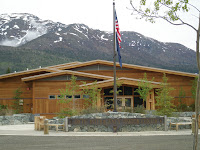



We are just about to the end of our visit in Fairbanks, Alaska. It’s amazing how quickly these six weeks flew by! Our time at Creamer’s Field as volunteer Refuge Hosts was a very positive experience; we got to know so much more about the people, the area, and the wildlife than we would have otherwise. Being here for six weeks gave us enough time to explore the area on our non-working days, and we were able to do almost everything on our list.
We were lucky enough to be here before the Fairbanks “green-up” which is when everything turns from winter brown to lush green. When we arrived in mid-May, all the hills were brown, and there were no leaves on the trees. In a matter of two weeks, everything was green, and you would never have known it was the same place. I feel fortunate to have witnessed that transformation.
We were also lucky to be here for Solstice, which is a very big event in Fairbanks. There were weekend long festivities, culminating in a Midnight Sun Run (10K) at 10:00 p.m. June 21st. It was a fun run, with lots of people in costume, street parties along the route, and the sun up and shining the entire time! I thought I would have a hard time running this time of day, usually I am going to sleep about that time, but to my amazement, I ran it a couple minutes faster than my previous best!
Wednesday June 25 is departure day. As always, we leave here with mixed feelings – ready to move on to our next adventure, but sad to leave behind new friends and somewhere we called home, no matter how briefly. But so it goes when you live life on the road.
Next stop: Denali National Park!
















